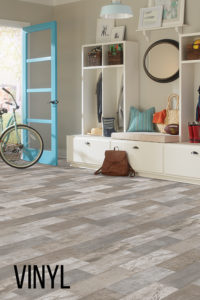Vinyl Flooring vs Laminate Flooring

One of the most common debates in the flooring industry is, which is better: luxury vinyl vs. laminate? Both types of flooring offer distinct cost and maintenance advantages over expensive natural materials such hardwood and tile. Both laminate and vinyl also offer durability, health and aesthetic advantages over traditional carpet flooring.
They both share the benefit of being extremely versatile in color through 3-D printing that allows them to resemble hardwood or stone. Both flooring materials are also easily replaced when compared to natural material or carpet, since only plank or tile will need to be removed.
Despite their similarities, there are very distinct differences between the two types of flooring products, which you should consider when you are shopping for the perfect flooring for your home.
Laminate Flooring
Laminate flooring is constructed in layers and stuck together through a lamination process. The main layer is made out of a high-density fiberboard, which makes the material much more rigid than luxury vinyl.
Laminate flooring is installed using click and lock assembly, also known as a “floating floor” system, meaning it does not need to be nailed or glued down to the subfloor. This makes for an easy installation process for DIYers, but also means that the flooring material should NEVER get wet. Moisture and humidity can severely damage laminate floors due to the sponge-like fiberboard layer and aerated gap underneath. Installation of laminate flooring in bathroom, kitchen or other high moisture areas is not recommended for this reason.
Luxury Vinyl Flooring
Don’t confuse luxury vinyl with traditional vinyl flooring. Luxury vinyl flooring is constructed using polyvinyl chloride, or PVC, which gives the material a firm but elastic constitution. The material is considered “resilient” due to its ability to compress and expand with contact instead of cracking.
The biggest improvement over traditional vinyl flooring is that the flooring is moisture-resistant. Luxury vinyl flooring can handle full liquid submersion without warping or discoloration, which is an extremely rare characteristic when compared to other home flooring materials.
Luxury vinyl flooring is also protected by durable “wear layer” of urethane for maximum protection and orthopedic comfort. The thicker the wear layer is, the more durable the flooring to high foot traffic.
Which Flooring Material is Recommended?
The only advantage laminate flooring has over luxury vinyl comes down to cost. Laminate flooring has a slightly lower upfront cost, but most laminate floors need to be replaced within 10 years. When compared to the average 20 year lifespan of luxury vinyl flooring, the latter is the most cost-effective solution.
In recent studies, many laminate floors have been found to produce formaldehyde emissions, which is a hazardous carcinogen. Breathing in formaldehyde on a daily basis can be potentially very dangerous and should be a concern for families with small children. In contrast, vinyl flooring has very little impact on indoor air quality within the home. Also, keep in mind that luxury vinyl flooring is a relatively recent industry innovation, while laminate flooring has been around for decades. The biggest difference between the two products is their reaction to moisture. Laminate flooring is extremely susceptible to humidity and water damage, while LVT is 100% waterproof.
Due to the differences in durability, product warranties also vary depending on flooring type. Laminate flooring typically comes with a 5 to 10 year warranty, whereas luxury vinyl flooring is usually warrantied for 15 years or more.
Overall, luxury vinyl is the clear winner. While both flooring materials may be similar in cost, appearance and maintenance, luxury vinyl flooring is less hazardous, waterproof and has double the lifespan and warranty of most laminate floors.

